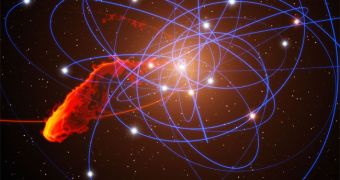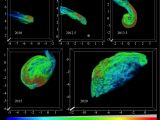The center of our galaxy, which like many others is home to a supermassive black hole, dubbed Sagittarius A*, has been rather quiet lately. Rather, it was quite a few tens of thousands of years ago when the things we see now happened.
But it won't be for long, astronomers have noticed that a pocket of gas heading its way is heating up as it gets closer. It's going to pass quite close, which means we're going to see quite a spectacle starting about a year from now.
Well, we won't see it, but astronomers using radio telescopes will and they're going to tell us all about it.
The discovery of the cloud, dubbed G2, prompted astronomers to try and find out where it's headed and how it will be affected by the black hole.
Computational physicist Peter Anninos along with astrophysicist Stephen Murray along with Chris Fragile, their former postdoc, put together a simulation to try and discover the fate of G2.
They used Cosmos++ and ended up with six simulations, after 50,000 computing hours on a 3,000 processor cluster.
They found that G2, which is made up of hot dust and super-heated gas, will survive its brush with death, but it will not escape unharmed.
In fact, it's very likely that the cloud will be severely impacted by the gravity of the black hole. However, it will pass fast enough and far away enough from the black hole to eventually escape its clutches.
G2's origin is unknown, it could be the remnants of a star, or a portion of a star's atmosphere that was blown out. It could also have been the early stages of a gas giant that failed to form due to the extreme heat. The dust in the cloud has been measured at 550K, 276C while the gas at 10,000K, twice as hot as the surface of the Sun.

 14 DAY TRIAL //
14 DAY TRIAL // 
